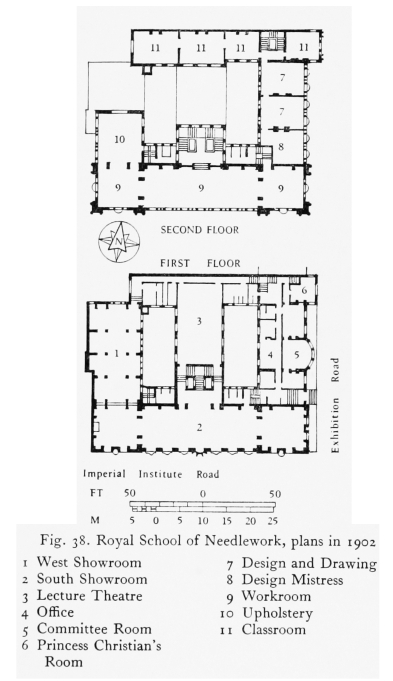Survey of London: Volume 38, South Kensington Museums Area. Originally published by London County Council, London, 1975.
This free content was digitised by double rekeying. All rights reserved.
'Royal School of Needlework', in Survey of London: Volume 38, South Kensington Museums Area, ed. F H W Sheppard (London, 1975), British History Online https://prod.british-history.ac.uk/survey-london/vol38/pp231-232 [accessed 8 May 2025].
'Royal School of Needlework', in Survey of London: Volume 38, South Kensington Museums Area. Edited by F H W Sheppard (London, 1975), British History Online, accessed May 8, 2025, https://prod.british-history.ac.uk/survey-london/vol38/pp231-232.
"Royal School of Needlework". Survey of London: Volume 38, South Kensington Museums Area. Ed. F H W Sheppard (London, 1975), British History Online. Web. 8 May 2025. https://prod.british-history.ac.uk/survey-london/vol38/pp231-232.
CHAPTER XVII - Royal School of Needlework
In 1872 the School was founded in Sloane Street, as the School of Art Needlework, with the purpose of reviving the art of decorative embroidery. (fn. 1) Its President was Queen Victoria's third daughter, Princess Christian of SchleswigHolstein, and in a prospectus attention was 'specially called to the fact that all Members of the School, including those who have charge of the showroom, are Gentlewomen by birth'. In 1875 the School moved into premises on the 1851 Exhibition Commissioners' estate west of Exhibition Road, previously occupied as the Belgian and Australian annexes of the 1871–4 Exhibitions. Here the School had a display-room fitted up with 'thoroughly artistic furniture' made by W. H. Lascelles's joinery firm to Norman Shaw's designs. (fn. 2) In 1883 Princess Christian was thinking of a connexion with the neighbouring City and Guilds College: (fn. 3) by the standards of the time this would have made an unusual social conjunction.
In 1892 the School obtained an impressive site on the northern corner of Imperial Institute and Exhibition Roads (plan c between pages 54–5) for a permanent building. (The lease from the Commissioners for 999 years from 1898 was concluded in 1901.) It was to cost about £12,500 and to be designed by the Lady Superintendent's brother, the architect Fairfax B. Wade. A view exhibited by him at the Royal Academy in 1893 shows a building in a kind of Jacobean style with shaped gables, and greatly pleased The Builder. (fn. 4) Work did not, however, begin until 1898, by which time the style had been radically changed, and the proposed cost had risen to £32,000. The School had less than half this sum in hand but borrowed the remainder from the Commissioners at 3frac;34 per cent. The Prince of Wales laid the foundation stone in June 1899. (fn. 5) The construction, by G. H. and A. Bywaters and Sons, was of fine quality and at 1s. 3d. per cubic foot not thought disproportionately expensive, but Wade's control of the cost was proving inadequate and by 1901 the estimated sum for completin had risen to £53,000: the Chairman of the Technical Education Board of the London County Council commented that parts of the front walls were almost soldi masonry, and that there were 'very few buildings erected nowadays with such a depthof bedding provided in the Portland stone'. The Commissioners gave another small loan, and to help the finances parts of the building, to include well-equipped electrical engineering laboratories, were let off to the City and Guilds College. (fn. 3) The building was finished for occupation in 1903.
Beneath it a portion of subway was made on the line of a possible continuation of that from South Kensington station. (fn. 6)

Royal School of Needlework, plans in 1902
Wade's choice of materials gave pleasant, fresh colours—green Westmorland slates, Bracknell red bricks and Portland stone banded with blue Pennant. The excellent stone-carving was by Henry McCarthy. (fn. 7) The design, in which the influences of Belcher's Chartered Accountants' building and Aston Webb's competition design for the South Kensington Museum are discernible, was praised at the time for the breadth of treatment that enabled the building to hold its own with the larger neighbours to west and north by Collcutt and Waterhouse (Plate 73a, b; fig. 38). (fn. 8) The latter had approved Wade's design on behalf of the Commissioners. It is significant of a diminished habit of enrichment that in 1952 the design was called, not broad, but 'pretty' and 'busy'. (fn. 9) (Whether Wade was wholly responsible for this design, so different from that of 1893, was doubted by Mr. Goodhart-Rendel, who was inclined to give the credit for it to Wade's assistant, J. Leonard Williams. (fn. 10) )
In 1934 Imperial College took over the lease, (fn. 2) and in 1949 the School moved to smaller premises in Princes Gate. (fn. 11) The building was demolished by the College, as part of its expansion, in 1962.